You Tube Review of Blockbeards Balance Boat Balancing Game by Imagination Generation
- Get link
- X
- Other Apps
3D scanners are changing how nosotros make, pattern, and meet the earth. Past projecting lasers or structured light, these scanners create entire 3D digitized models of concrete objects in just seconds.
Sometimes called 3D laser scanners, 3D model scanners or 3D object scanners, 3D scanners are integral for rapid prototyping and other forms of 3D printing, for saving historical artifacts as digital models, and have extensive uses in dentistry for creating perfect-fitting implants and dental models.
Budget Selection
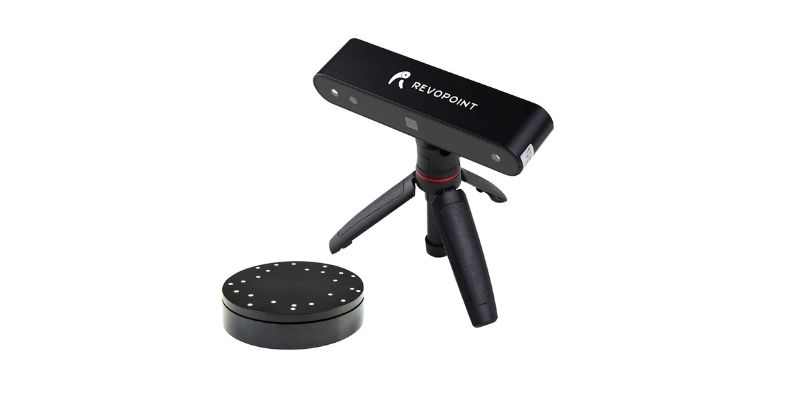
Revopoint Popular
Versatile and portable (just 200g) with handheld and stationary options
0.3mm accuracy on a small scanner that costs under $600
Available at:
MID-RANGE Choice

Matter & Course V2
Accurate 0.1mm scans
Powerful stationary scanner for 25x18cm objects
Comes with specialized software
Available at:
PREMIUM Option

Shining 3D EinScan H
0.05mm scan accuracy and 0.25mm resolution with 1.2 million points/s
Infrared scan sensors make scanning darker colors easier
Available at:
Offset developed and used simply for industrial applications, now you lot can pick up powerful low-price 3D scanners for simply a few hundred dollars, and if you lot're content with low-quality basic scans, you tin even employ your telephone!

To rank the best 3D scanners, nosotros used criteria such equally scan quality and price-functioning ratio, ease of employ, versatility, and more. We grouped the scanners by toll range: cheap 3D scanners under $1,000; medium-priced 3D scanners under $10,000; and industrial 3D scanners over $10,000.
The Best 3D Scanners for All Prices Ranges
| 3D Scanner Make & Proper name | Type of 3D Scanner | Price | Where to purchase and where has the all-time toll |
|---|---|---|---|
| Revopoint 3D POP | Structured Light | $500 | Revopoint 3D here |
| Creality CR-Scan 01 | Structured Light | $700 | Creality Store here |
| SOL 3D scanner by Scan Dimension | Desktop 3D Scanner | $699 | Amazon here |
| BQ Ciclop | Light amplification by stimulated emission of radiation Triangulation (DIY) | Depends if pre-assembled or DIY | Amazon here |
| Matter & Form V2 | Desktop 3D Scanner | $749 | Amazon here |
| Shining 3D EinScan SE | Desktop 3D Scanner | $1,399 | Amazon hither |
| EinScan H | Handheld | $iv,999 | Dynamism Store here |
| Shining 3D EinScan Pro 2X Plus | Handheld 3D Scanner | $half-dozen,800-$viii,300 | Amazon here |
| Scantech iReal2E | Handheld 3D Scanner | $iii,980 | Scantech Site |
| Artec EVA | Industrial 3D Scanner | $nineteen,800 | Artec |
| Scantech SIMSCAN | Portable 3D scanner | Contact for price | Scantech site |
| Scantech KSCAN | Handheld 3D Scanner | Contact for price | Scantech site |
Only before we become into the best scanners, hither's a quick intro to how 3D scanners work:
How does a 3D scanner work?
3D scanners create point clouds based on images taken of a solid surface or object — basically huge numbers of information points that denote where an object is — to create a 3D model of the scanned part. Millions of individual data points brand upwards the larger 3D measurement, which tin and so be imported into 3D CAD software to edit and optimize the CAD model.
3D scanning includes several different technologies, such as Structured Low-cal scanning and Laser Triangulation, besides as varying across types of scanner, such equally stationary and handheld 3D scanners.
Other forms of 3D scanning include photogrammetry. This involves taking a large number of individual photos of a stationary object, each at slightly different angles, and then collating them together to create an accurate 3D model.
3D scanning makes for far more efficient 3D fabricating and iterating. They tin can both quickly create digitized versions of objects, and scan existing objects to act every bit quality control for whether they are perfectly precise or if they need to be fixed in a futurity iteration.
3D Scanning to 3D Impress
3D scanners are often used to create 3D printable models, with 3D scanner and 3D printer setups allowing you to replicate well-nigh anything in front of you lot. Simply use the 3D scanning camera to create a digital model of your object, and then 3D print the scan.
Big objects can exist scanned using handheld 3D scanners and moved around the object's dimensions, and and so sized down and 3D printed as a scale model. These 3D printer scanner combos offer almost limitless versatility.
The All-time 3D Scanners 2022: Budget Picks
3DSourced is reader-supported. When you purchase through links on our site, we may earn an affiliate commission. Learn more
Revopoint Pop
- Price: $500-$550 — Available at Revopoint store here
- Resolution: 0.three mm
- Max Scan Volume: 210 x 130 mm
- Engineering: Structured lite
- Speed/Frame Rate: viii FPS

Born of a hugely successful Kickstarter funding run, the Revopoint POP is another well-priced, highly portable, hand-held slice of tech vying for the best budget 3D scanner crown.
It uses dual-camera infrared binocular structured low-cal tech housed in a compact 155 x 38 x 27 mm design weighing no more than 200g, perfect for on-the-move scanning. Further propping up the scanner's portability chops is that you lot can run it using a telephone if you're out and about cheers to the easy-to-use Revopoint HandyScan app.
While cheap, the Revopoint POP even so packs a considerable dial courtesy of a 0.3 mm resolution. The number is theoretical and very much a best-case scenario, but in action, the Revopoint Popular delivers brilliant prints for the cost, with authentic textures and solid details.
With a 210mm x 130mm unmarried capture range and 100 mm to 275 mm scanning range, and eight FPS scan speed, the Revopoint POP isn't the fastest out at that place by any stretch of the imagination, merely you lot can browse a confront in under xxx seconds.
The Revopoint Pop besides has several scanning modes tuned to go the most out of specific applications. These include a human scan for lifelike replicas of faces and bodies, marker mode, feature manner, dark mode, and an outdoor scan mode. An RGB sensor allows for color capture, too.
Alongside, the Revopoint POP apace morphs into a fixed scanner by deploying legs mounted on the handle. Revopoint sells an accompaniment turntable, as well, should yous want fifty-fifty easier stock-still small object scanning.
For usa, the Revopoint Pop is a height choice for those balancing a tight budget and a demand for a little more accuracy and higher resolution than other budget scanners like the Creality CR-Scan 01.
Creality CR-Browse 01
- Price: $650-$700 — Available at Creality Official store here / Amazon here
- Accurateness: 0.i mm
- Resolution: 0.5 mm
- Max Scan Book: 536 x 378 mm
- Engineering: Structured light
- Speed/Frame Charge per unit: x FPS
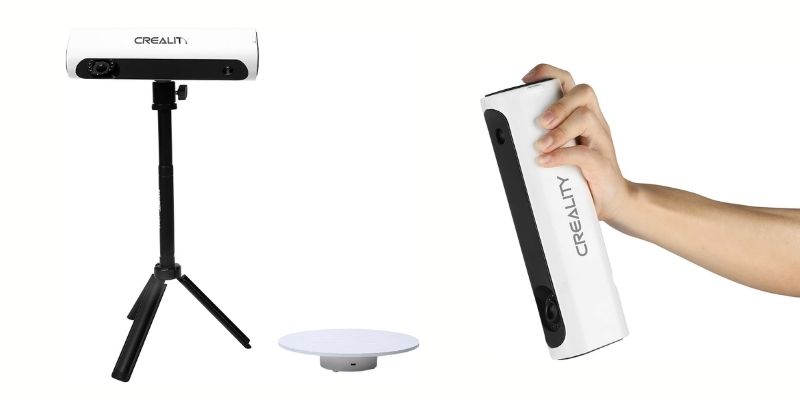
With a cemented reputation for offering some of the best upkeep 3D printers on the market today, Creality aims to practice very much the aforementioned with the affordable Creality CR-Browse 01 3D scanner. It employs structured light applied science to feel out the shape, size, and texture of a 3D object to generate a digital reproduction.
Creality has outfitted the CR-Scan 01 with both a handheld mode and a stationary turntable way, each with their own set of advantages. In handheld way, the scanner speedily works through larger objects, offer flexibility and on-the-fly capture. Switch to turntable mode, and the tripod-mounted Creality CR-Scan 01 creates an automated, higher-accuracy 360° scan every bit the object rotates on the turntable.
Both modes offer accuracy of 0.ane mm, a resolution of 0.5 mm, 24-bit high-fidelity color mapping, and marking-free scanning thanks to a clever alignment algorithm.
The Creality CR-Scan 01 too makes smart adjustments based on light levels, making information technology suitable for low-light environments. These are all excellent features for the asking cost and sufficient for nigh hobbyist scanning needs, although somewhat lacking for high-precision scanning.
Notwithstanding, where the Creality CR-Scan 01 shines is a altitude of 400-900 mm, which outclasses well-nigh budget 3D scanners, sided past a scanning area of 536 x 378 mm. In do, yous tin scan medium to large objects further away with a larger frame size, which speeds up the scanning process considerably.
Finally, the bundled Creality'due south CR Studio is a robust mail service-processing suite with all manner of editing, repair, colour, and smoothing tools to polish off digital scans fix for 3D printing or other applications.
SOL 3D Scanner past Scan Dimension — Perfect desktop 3D scanner
- 3D scanner cost: $699 — Available on Amazon here
- Visitor based: Denmark
- Accurateness: upwards to 0.1 mm
SOL is a desktop light amplification by stimulated emission of radiation scanner designed for scanning small withal detailed items, with adept accurateness for the price. The actual scanner itself weighs merely 7 pounds, and can browse objects that weigh upwards to 2kg. This light weight makes it a perfect portable 3D scanner if you're on the move, for example if you want to browse objects in dissimilar places.
It has ii different modes depending on what you're scanning:
- Near style: for scanning objects of upward to 100 mm in diameter and 100 mm in height.
- Far mode: for scanning objects up to 170 mm in bore and 170 mm in height.
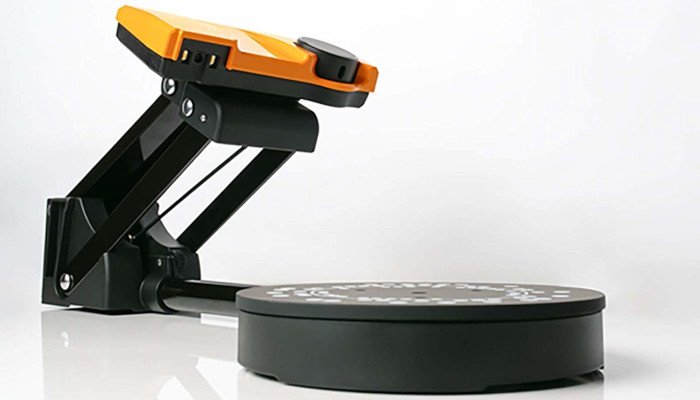
The SOL boasts an accuracy of around 0.one mm, extremely expert for the price range. You browse objects with their included SOL 3D software, and can then hands export your scans equally OBJ or STL files and import them into a 3D slicer for 3D printing.
The Danish company promote this impressive 3D visualizer non only for makers or hobbyists, only also for entrepreneurs. They sell the SOL 3D scanning photographic camera as a style for entrepreneurs to show their products off with a 360 degree view, with like shooting fish in a barrel ways to share these scans on Facebook. Additionally, Browse Dimension say the scanner is besides perfectly suited for didactics, for instruction students STEM teaching through scanning and editing structures.
Overall, it'due south well suited equally both a 3D scanner for businesses, also every bit a home 3D scanner for hobbyists.
BQ Ciclop — All-time home 3D scanner
- Cost: Dependent on buying/making — Available on Amazon hither
- Company based: Spain
- Resolution: 0.5 mm
- Maximum scan book: 200 x 200 ten 205 mm
- 3D scanning technology: Light amplification by stimulated emission of radiation Triangulation
Unlike many scanners, this DIY 3D scanner is open source, with all the files hosted on Thingiverse for you to download and print. The Ciclop has proven popular, with tens of thousands of downloads on Thingiverse alone. BQ provides all of the information, software, and electronics for this 3D scanner kit which you can modify for yourself on their website.
The BQ Ciclop 3D scanner uses light amplification by stimulated emission of radiation triangulation technology, and can scan objects in a few minutes. Moreover, the instructions that BQ provide with the kit allow anyone — even a beginner! — to assemble the scanner in under an hour. BQ host downloads for all the drivers for the camera and firmware that you demand, and developed a specialized 3D scanner app chosen Horus for scanning on your Ciclop.
It'southward uncomplicated but effective. Information technology's made from ten 3D printed parts (download .STL files from Thingiverse), a threaded rod, a Logitech C270 webcam, two line lasers, and a turntable platform with a stepper motor, though y'all can edit and modify information technology equally you wish. It's simplicity has led to Cowtech making their ain model in 2015 which raised $183,000 on Kickstarter.
The BQ Ciclop scans a volume of 250 ten 205 mm and has a resolution of upwards to 0.3mm. Information technology can be continued via USB or Bluetooth, and is therefore a versatile and affordable low-cost 3D scanner for beginners to 3D scanning.

Matter and Form V2 MFS1V2 — One of the all-time 3D scanners under $1,000
- 3D scanner cost: $749 — Available on Amazon here / Available on Matterhackers here
- Company based: Canada
- 3D Scan Accuracy: 0.1 mm
The Matter and Form V2 is an updated version of the original desktop 3D scanner made by the Canadian tech startup. This depression-cost 3D scanner uses two lasers and a HD-CMOS sensor to produce high-resolution, full-color 3D scans.
The scanner has an accurateness of upwardly to around 0.1mm, and is easily connectable to your figurer through USB to transfer over your scans. For editing scans, the Matter and Class scanner comes with specialized Mfstudio and Quickscan 3D software to brand sure your scans look perfect. Yous can then export the .STL files and print them with your 3D printer.
The 3D scanner can scan objects in size up to 25 cm tall and eighteen cm in diameter. It is compatible with every major OS, so Mac users needn't worry. What we similar most yet is that information technology folds up, making it a perfect portable 3D scanner.
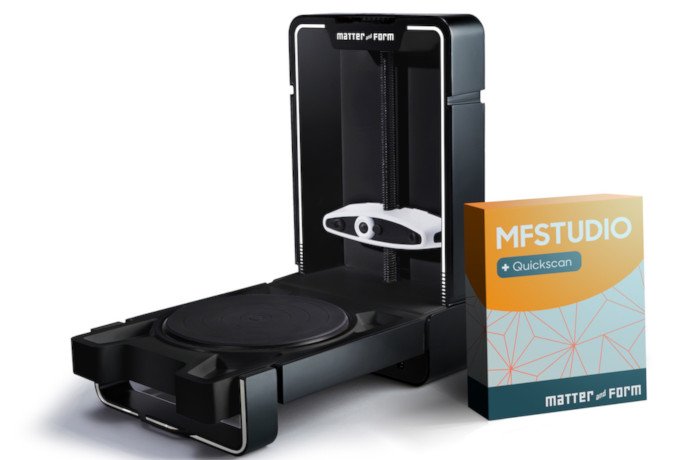
Medium Priced 3D Scanners: $1,000 to $10,000
Shining 3D EinScan SE — All-time 3D scanner nether $i,500
- 3D scanner price: $1,399 / £1,130 — Available on Amazon here / Dynamism here
Shining 3D have made a name for themselves in the medium-range 3D scanning sector recently, with cheaper options such as the EinScan-SE as well every bit more than expensive scanners similar the EinScan Pro 2X Plus.
The EinScan SE is one of the best 3D object scanners in its toll range. It scans in effectually 8 seconds (versus 4 seconds for the EinScan SP) and can complete a whole 360-degree scan in its Automatic Scan mode in around 2 minutes. It tin can scan objects up to around 200 mm broad and 150 mm tall, with a unmarried shot accurateness of effectually 0.1 mm — making it a great 3D printer scanner.
Overall, this 3D model scanner is accurate, reliable, and makes it piece of cake to quickly scan stationary objects and 3D print them with ease. The EinScan SP — described in more detail further in this guide — is more than precise, but costs more. Therefore, it'south a affair of your budget and how important this additional quality is for you personally.
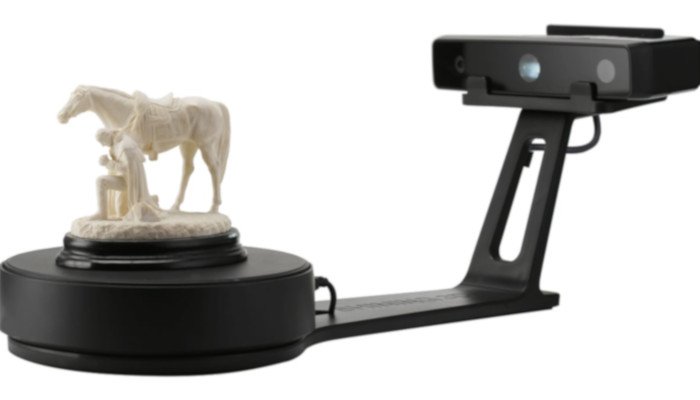
EinScan H
- Price: $v,000 — Available at Dynamism here
- Accurateness: 0.05 mm
- Resolution: 0.25 mm
- Max Scan Book: 780 ten 900 mm
- Engineering: Hybrid structured light LED and infrared
- Speed/Frame Rate: 1,200,000 points/s, 20FPS

The EinScan H is a professional-grade handheld 3D scanner that combines speed, accurate reproduction, and ease of use with a particular emphasis on bringing usually catchy 3D objects to digital life.
The EinScan H combines two calorie-free sources – structured LED and invisible infrared – to cover a wide range of 3D objects, modes, and applications. For example, the infrared calorie-free excels at capturing the item and intricacies of darker colors, notably those of human pilus and full general facial scanning. An added benefit of the invisible calorie-free is more than comfortable scanning for the field of study and no on-face up glare to complicate the scanning process.
Manufacturer Shining 3D has also gone to considerable lengths to merge impressive accuracy and resolution along with fast scanning speeds. The EinScan H pushes a resolution of 0.25 mm with accuracy as depression as 0.05 mm, all at roughly 1,200,000 points/s at 20FPS. The scanner also features accurate, full-color reproduction with solid texture mapping that translates to systematically excellent scan quality.
Co-ordinate to Shining 3D, it's possible to scan an entire homo body in fine detail in a matter of minutes. A generous 420 ten 440 mm single capture range helps go along things speedy fifty-fifty when scanning large objects aided by an optimized alignment algorithm to keep scans well-baked and precise.
Although priced at $5000, the EinScan H falls roughly in the affordable range and is a versatile tool suited for healthcare, art, forensic scientific discipline, and other professional 3D modeling applications.
Scantech iReal 2E Color 3D Scanner — A complete 3D scanning solution
- Cost: $three,980
- Scanning area: Upward to 850 mm x 800 mm
- Accuracy: Upward to 0.100 mm
iReal 2E is a professional handheld colour 3D scanner manufactured by Scantech. The visitor specializes in developing, manufacturing, and selling intelligent visual inspection equipment and sells an unabridged range of 3D scanners for various applications and sectors.

The iReal 2E uses cherry-red VCSEL structured light technology to offer you a unproblematic and prophylactic 3D scanning feel, eliminating the issues of dazzling lights and difficulties in pilus 3D scanning. Without attaching markers, a quick and accurate texture and geometry scan can be achieved with a broad scanning area of 850 mm x 800 mm, 750 mm depth of field, ane.5 one thousand thousand measurements per 2d, and at 0.100 mm accuracy. Mixed alignment modes meet various scanning situations.
Shining 3D EinScan SP
- Price: $2,500 / £2,000 — Available on Amazon hither / Dynamism here
- Company based: Prc
The 2nd Shining 3D medium-range 3D scanner in our ranking, the SP is cheaper than some of their more premium models like the Einscan Pro range, but still very constructive. It is more than accurate than the EinScan SE, with accurateness up to 0.05 mm rather than 0.1 mm, and scans single shots in half the time (4s vs 8s). Double the price, double the accuracy — and half the scanning fourth dimension.
The scanner utilizes white light scanning technologies to make very authentic scans of objects as small-scale every bit xxx ten 30 x 30 mm. Total objects are typically scanned in less than a minute, and images in less than four seconds. What'south more, despite its cheaper price, many Amazon buyers take reported that it can compete with scanners costing 10 times as much for scan quality! It as well comes with a tripod.
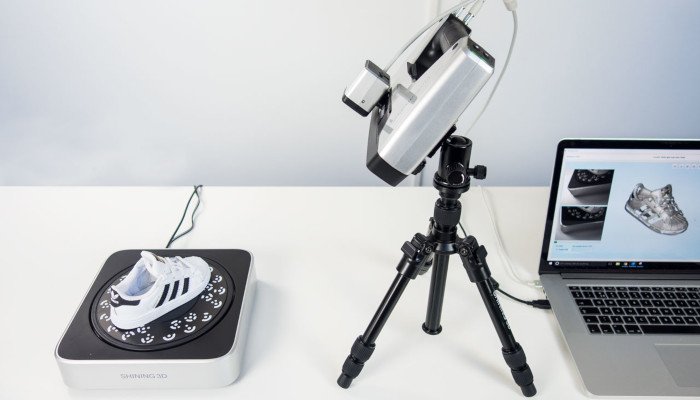
Shining 3D EinScan-Pro 2X Plus — One of the all-time 3D scanners effectually
- Price: $6,900 for the scanner, $eight,300 for full industrial pack — Available on Amazon here / Dynamism here
- Company based: Mainland china
Shining 3D produces a number of different 3D scanners for unlike price points. The EinScan-Pro 2X Plus can be used as a stock-still or handheld 3D scanner to capture objects of varying sizes. The EinScan-Pro 2X Plus uses white light 3D scanning technologies to increase accuracy and scan faster, creating high-quality scans in record fourth dimension.
This 3D scanner's price is significantly higher than the other Shining 3D scanners on our ranking, but the 2X Plus comes with a number of key advantages. You can simply hold the scanner and point it towards the object or room you want to 3D scan, and instantly tape crisp scans of your environs. You may want to 3D scan a auto, your friend, or even turn it into a baby 3D scanner for a 3D memory of your child earlier it grows upwards!
Chinese company Shining 3D first came onto the scene with a successful Kickstarter campaign, raising over $120,000. Since and then they've expanded, and now this 3D scanner is accurate up to 0.03mm for objects less than 4m away.
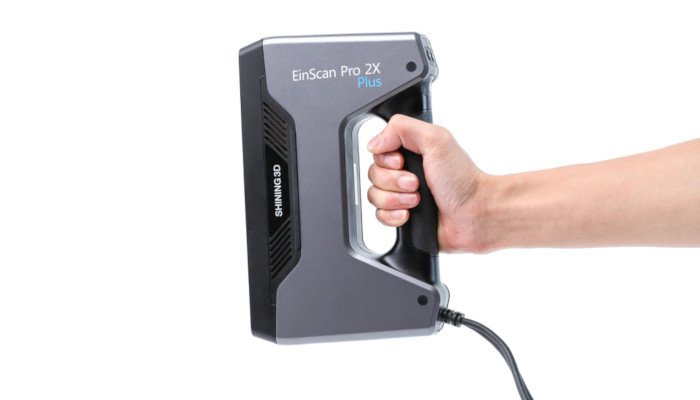
Industrial & Professional 3D Scanners: $10,000+
Artec EVA — Powerful handheld 3D scanner
- Industrial 3D scanner toll: $19,800
Creating new innovative solutions in 3D technology since 2007, Artec 3D is a global leader in handheld 3D scanners. Their most popular scanner, the Eva, is a handheld, industrial 3D object scanner, and an first-class solution for medium-sized objects ranging from motorcycle wheels to car exhaust systems, human being busts and facial close-ups.
Low-cal, quick, and versatile, Artec Eva captures precise measurements in high resolution, while structured light scanning technology makes the scanner safe to apply in whatever state of affairs – fifty-fifty difficult to scan surfaces such equally black or shiny surfaces are effectively captured by Eva.
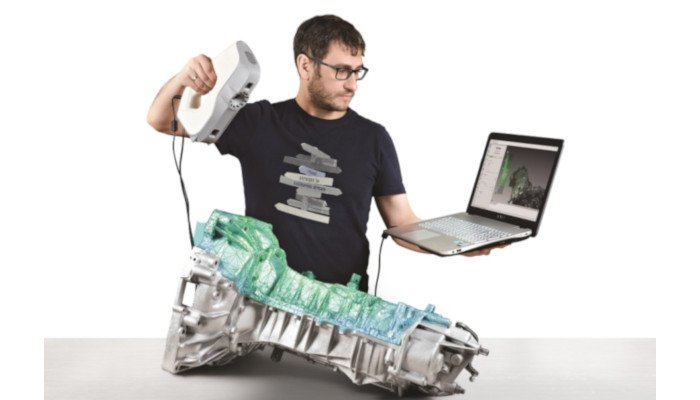
Ideal for use in industries including product design, heritage preservation, healthcare, and reverse engineering, this market place leader can accurately browse total-color objects at a range of upwardly to 100cm with color and texture, making it a great solution for fast and accurate 3D models.
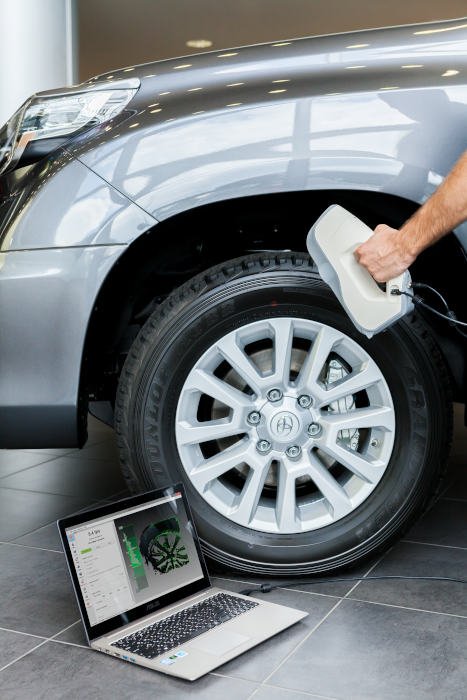
Scantech SIMSCAN — hand-sized portable 3D scanner
- Accuracy: upwardly to 0.020 mm
- Resolution: up to 0.025 mm
- Scanning area: up to 410 10 400 mm
Scantech's SIMSCAN consists of two sets of industrial black & white cameras, a laser projector with 30 laser lines, and a set of multifunctional buttons. Its high-quality components ensure fast and stable 3D scanning.
Information technology features 3 scanning modes: ultra-fast scanning, hyperfine scanning, and deep hole scanning optimized for different scanning situations. With its intelligent auxiliary lights, it tin can even browse darkly lit objects.
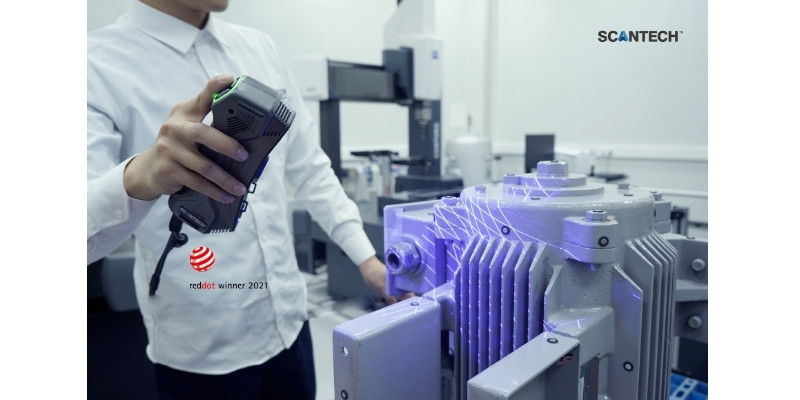
Powered by a robust algorithm, SIMSCAN'south measurement rate can be upwardly to 2.02 one thousand thousand measurements/southward with an accuracy of up to 0.020 mm. It has a field of view of upward to 410 x 400 mm.
With a net weight of 570g, SIMSCAN tin exist among the meridian list of the nearly lightweight and portable 3D scanners in the market. It is designed for both beginners and professionals to conduct 3D scanning regardless of ambient conditions. Thanks to its compact size and portability, SIMSCAN enables on-site and efficient 3D scanning, and it suits well for scanning hard-to-achieve areas.
Made from aerospace-form aluminum-alloy, Scantech'due south SIMSCAN scanner is sturdy and durable and performs well in heat dissipation. Its textile ensures a prolonged use of the 3D scanner. With an anti-sideslip beat out and a mitt strap, yous can orient this scanner in any manner you choose to suit your 3D scanning needs.
Scantech KSCAN-Magic — industrial handheld 3D scanner
- Resolution: 0.010 mm
- Scanning charge per unit: 1,350,000 measurements/2d
- Scanning surface area: 1440 x 860 mm
Esteemed 3D scanner company Scantech take appear the launch of their latest KSCAN 3D scanner, with 5 five dissimilar modes for all types of scanning. These include a big area scanning way, fast scanning mode, photogrammetry, also as a fine scanning mode. Featuring both infrared lasers and blueish laser technologies allows the KSCAN-Magic to achieve a broad range of scanning functions finer.
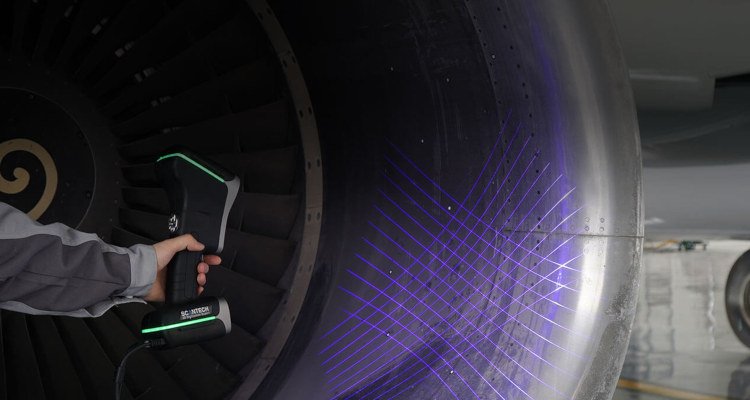
It scans accurately, quickly, tin handle small and big objects, and is designed to advance time-to-market. The 41 equipped laser lines can handle an incredible 1.35 million measurements per second, creating detailed scans in record fourth dimension.
If you lot are looking for leading-edge 3D solutions for your business organisation, KSCAN definitely surpasses expectations with its resourcefulness and precision.
Heir-apparent'southward Guide – Things To Consider When Ownership A 3D Scanner
Budget
Expect to pay anywhere from $400 to $200,000 for a 3D scanner. There are numerous options suited to all budgets dotted between those two extremes.
Entry-level hobby scanners suitable for 3D printing are available for less than $1,000, while more than robust machines suited for light-professional scanning sell for around $v,000.
Should you want the foam of the crop scanners designed for the most-demanding industrial-level applications such as engineering science, expect to pay more than $10,000.
Speed
When applied to 3D scanners, speed refers to the rate at which a machine captures or scans a 3D object. Consumers and nigh professional 3D scanners record speed in points per second or frames per second. The higher the count, the faster the scanner.
If you're buying for a professional setting where productivity is critical, nosotros recommend eyeing faster printers, which by and large push button points per 2d into the millions and frame rates around 20 FPS.
Resolution and Accuracy
Accuracy refers to how well the finished digital object matches its real-globe analogue. Accuracy pops up in specification sheets expressed in mm, which indicates to what degree the 3D scan sticks to the shape, size, features, etc., of the real-world object.
For a budget 3D scanner, 0.1-0.2 mm is a solid reference indicate, while much more expensive industry scanners tin can bound to as depression equally 0.009 mm on the most powerful devices.
Though like to accuracy, the resolution refers to the smallest possible altitude between points on a 3D browse. In layman's terms, a higher resolution delivers finer details and more than intricate, faithful features. You'll find manufacturers refer to resolution in mm, a measure that balloons and shrinks based on the price of the 3D scanner.
Budget printers waver around 0.3-0.5 mm, while professional scanners can push button resolutions as loftier as 0.ane mm.
Software and Connectivity
Connectivity refers to how a 3D scanner allows you to scan, export work, and interface with a PC or other device besides equally the source of power. In about cases, USB is the standard, with some outliers offering Bluetooth.
If you're looking for portability, consider handheld scanners that pair with Smartphones and power banks so you can rapidly scan on the movement.
Software tied to 3D scanners come in all shapes and sizes, from barebones scanning tools to advanced suites with all manner of mail-processing touch-up options.
It goes without saying that software capabilities match the target audience of each scanner. Pay more for a professional scanner, and the software generally features a more than robust set of tools.
Use Case
Entry-level 3D scanners are a good option for hobbyists looking to browse objects with 3D printing in mind. They are only most affordable and work well, although they lack the detail and speed of pricier models.
We recommend handheld 3D scanners for larger models. These grant a caste of freedom and motility to capture all the particular and breadth of bigger objects. A big scan expanse helps speed upwards scanning large objects, as well.
For modest fixed object scanning, where capturing all the rich details and texture of a model tops your list of requirements, look to stationary scanners, ideally with a turntable, tripod, and an optimized alignment algorithm.
3D Scanner Costs
Budget/entry-level
Thanks to efforts from companies similar Creality and Revopoint, there'south a concerted effort to lower the cost of entry and boost accessibility to 3D scanners.
It's at present possible to purchase a decent entry-level scanner for nether $i,000, with ultra-budget options similar the Phiz 3D scanner dropping equally low as $400.
Fifty-fifty though the feel and features measure upwardly to the toll paid, upkeep 3D scanners offering everything needed to create decent quality scans suitable for hobbyist applications.
Read more: the top depression-cost 3D scanners
Mid-range
Jumping up to the mid-range category, yous'll find 3D scanners priced anywhere from $1,000 to $ten,000. These are more often than not professional person-form machines with a range of tech, modes, and first-class scan quality, striking a residuum betwixt functionality and price.
Top-range/Industrial
The top-shelf 3D scanners. Expect to pay upward of $10,000 for industrial-grade devices. These are very much no-compromise options boasting the meridian in accuracy, resolution, and scan speeds for industry applications such equally scientific measurements, contrary engineering science, demanding 3D visualization, architecture, and rapid prototyping.
3D Scanner Applications
Medical: custom orthopedics, wheelchair and mobility aids, prosthetics, plastic surgery implants, protective equipment, realistic dummies for training.
Dental: bespoke implant and crown blueprint suited to specific patients.
Jewelry: bespoke designs, repairs, and easy duplication/replication of damaged family unit heirlooms or discontinued jewelry with sentimental value.
Hobbyist 3D Printing: scanning existent-world objects for reproduction using a 3D printer. Miniatures, cosplay, household items and repairs, toys, and other functional parts.
Virtual Reality and Game Pattern: real-world object/landmark scanning for use in VR environments, and trunk scans to create realistic animations and in-game models.
Engineering: tolerance testing, quality control, data analysis, fully textured models, infrastructure building and monitoring.
Reverse Technology and Repairs: automotive, aviation, naval repairs, and restoration of antiquarian or discontinued vehicles.
Archæology and Conservation: heritage conservation of objects, artifacts, and skeletal remains.
Compages: building scanning for surveying, design, and contrary engineering degraded exteriors for repair.
Forensics: digital replicas of crime scenes to capture bear witness such as shoe prints, claret stains, bullet holes, and and then on.
The Main Types of 3D Scanner
The two most-used technologies are structured lite scanning and laser triangulation.
Structured Low-cal Scanning
Structured light scanning is commonly used in handheld 3D scanners and involves projecting patterns of light at an object, with two cameras commonly placed on either side of the projector to measure the low-cal pattern from each side and calculate precise differences at every indicate in their field of view.
These cameras measure out how the light deforms the low-cal pattern, and by triangulating these multiple different reference points across different images of the scan from each camera view, you can accurately calculate the dimensions of the object.
Equally a result of its portability and accurateness, dental 3D scanners typically use structured light scanning to scan patients' mouths and create dental implants and models. Beyond this however, architects and historians are using these types of 3D scanning to proceed digital records of priceless historical monuments, and NASA even use information technology to map interplanetary terrains.
However, the utilise of projected light makes information technology very sensitive to the lighting conditions in the scanning environment, so working outside or in other similar environments can be difficult.
Laser triangulation
Laser scanning involves projecting a laser point on an object and then using sensors to capture the reflections to gather data on the object's size. Based on the reflection angle from the light amplification by stimulated emission of radiation's sensors, the 3D scanner tin create authentic textures and surfaces using trigonometric functions.
However, considering it works off reflections it can be ineffective if scanning shiny or reflective surfaces, and won't piece of work well with anything transparent.
Structured low-cal scanning is generally considered more accurate than laser scanning, with less noise in scans.
LiDAR 3D scanning and Time of Flight 3D scanning
Another form of 3D scanning, and the technology used in the latest iPhone 12 Pro, is LiDAR. Light Detection and Ranging involves shooting out lite beams and calculating the object'due south area — based on the speed of light — on the time taken to reflect back to the Lidar 3D scanner.
These are very like to time-of-flying 3D scanners. These scanners shoot light pulses, calculating the time of flight for each pulse to create a 3D visualization — or point cloud. They're ordinarily used to map terrains, measure real estate, and in architecture and construction.
Handheld 3D Scanners
Portable and versatile past pattern, handheld scanners allow you to efficiently and freely browse large objects, narrow spaces, or all the details of a human subject field, for example.
Stationary 3D Scanners
Fixed scanners are a solid option if you lot plan to browse small objects and desire the device to exercise most of the heavy lifting. They more often than not come up with a stand or tripod and turntable. Automated scanning is likewise typically part of the deal here, with different modes of alignment to cull from.
3D Body Scanners
Equally the name implies, 3D body scanners are specifically designed to capture a full 3D scan of human bodies.
Towering machines, commonly priced in the tens of thousands of dollars, 3D body scanners provide a fast and accurate 3D torso scan for various applications, including health, fitness, animation, and more.
Read more than: our feature story on 3D body scanners.
3D Scanner FAQs
What Is The All-time 3D Scanner?
For those on a budget, our height pick is the Revopoint Popular. It'southward versatile, portable, affordable, and offers a solid level of accuracy for the price. The EinScan H is a solid mid-range option for businesses and professionals looking for fast, highly-accurate press. Finally, if you desire the all-time on the market place today and have the budget to spare, Scantech'south SIMSCAN and KSCAN or the Artec EVA are all meridian-shelf options for the about demanding applications.
What Is The Best 3D Scanner For Small Objects?
Nosotros recommend a stationary 3D scanner similar the BQ Ciclop for affordable home scanning, and the Shining 3D EinScan SP for professional person small object scanning.
What Is The Best 3D Scanner For 3D Printing?
We recommend the Creality CR-Browse 01. Creality has made the almost of its 3D printing know-how to design a scanner that blends seamlessly into the 3D printing workflow. It's compact, versatile, and reasonably accurate, perfect for most 3D printing hobby applications.
What Is The Best 3D Scanner For Reverse Engineering?
Scantech's SIMSCAN rises above the rest as our top choice for reverse engineering. It's especially adept at capturing highly-detailed and accurate scans of objects in difficult-to-accomplish spaces, perfect if you're looking to reverse engineer a function from an aging piece of machinery or antique motorcar, for example.
If you enjoyed this article:
Sign upwards to our email list and get the latest 3D printing news, buyer'southward guides and giveaways direct to your inbox:

Source: https://www.3dsourced.com/rankings/best-3d-scanner/
- Get link
- X
- Other Apps

Comments
Post a Comment